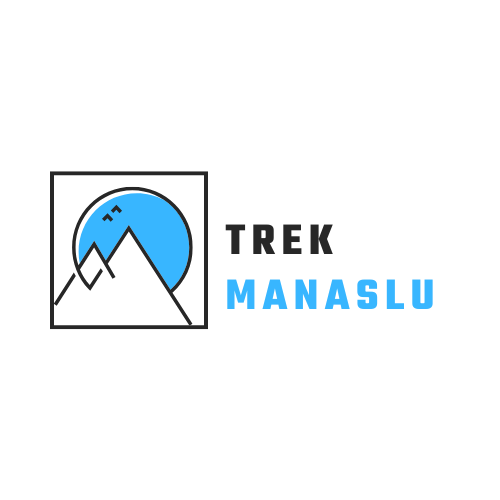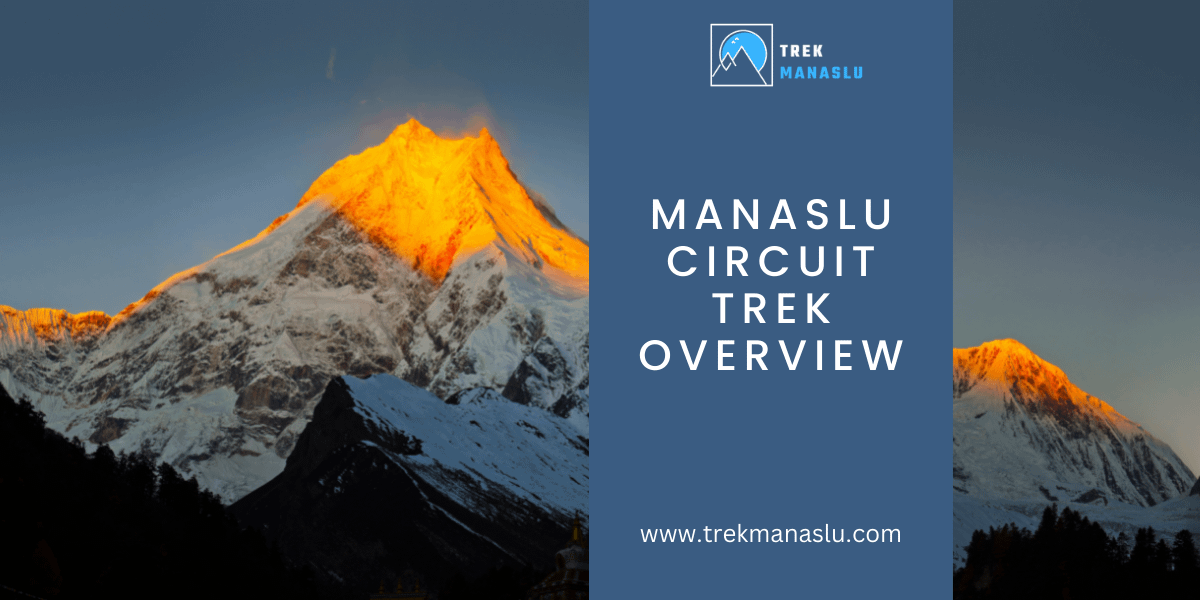The Manaslu Circuit Trek, also known as the Larkya Pass Trek, is an off-the-beaten-path trekking destination. The trek’s main scenic views include Larkya Peak, Larkya Glacier, Annapurna range, and Manaslu’s 3 peaks (Japanese peak).
It binds together the experience of crossing a high pass, getting closer to nature, and mountains ranging from 710 m (2329.4 ft) to 5160 m (16929.13 ft) while exploring the circuit trekking. As it is not as popular as other trekking destinations in Nepal, such as Everest Base Camp or Annapurna Circuit, it is not yet fully explored and crowded. Hence, it is peaceful and preferred by trekkers.
The Manaslu trek usually begins from Soti Khola and ends at Budhi Gandaki. Talking about the trek trail, it has a combination of steep valleys and descends, walking along some of the major rivers of Nepal, like the Marsyangdi River, high mountains like Himalchuli, and villages such as Budhi Gandaki.
Because of the region’s geographic location and the long distance you have to traverse every day, the Manaslu trek is difficult and adventurous.
Major highlights of the Manaslu circuit
- Has lesser crowded trails.
- Passing through Larkya La pass.
- View of Annapurna range and Japanese peak.
- Visit the Manaslu conservation area.
- The sight of 8 tallest mountains in the world.
- Exploring Buddhist and Tibetan Culture.
- Getting a closer insight into Budhi Gandaki Valley
Where is the Manaslu circuit Located?
Manaslu Base Camp lies in the Western Central part of Nepal at 4800 m (15748.03 ft) altitude.
The circuit trek begins at Sotikhola and ends at Budhi Gandaki. Mansiri Himal of the Gorkha district is the main geographical mark of this trek.
Similarly, Mount Manaslu, the major appeal of the Manaslu trip, is the tallest mountain in the Gorkha area and is located approximately 64 km/40 mi east of Annapurna.
Manaslu was included in the Manaslu Conservation Area in December 1998 under the National Parks and Wildlife Conservation Act. Nepal’s National Trust for Nature Protected (NTNC) oversees the conservation area, which is 1663 square kilometers (642 square miles).
Manaslu circuit trekking elevation
The highest elevation of the trek goes up to 5160 m (16929.13 ft) while passing through Larkya La pass. Other than that, the Manaslu circuit ‘s altitude falls in the margin of 710 m (2329.4 ft) to 5160 m (16929.13 ft). Elevation the trek throughout has a fair chance of getting altitude sickness.

The trekking route to Manaslu circuit
There are about 2 to 3 routes that lead to the Manaslu circuit trek. The current most favored route lies on the opposite side of the classic old route that starts from Sotikhola.
The initial part of the route of the classic trail goes through steep villages and descends down to the base camp. The route is moderately difficult as one walks through high passes and remote landscapes amongst massive cliffs and rocky paths.
Length of Manaslu Circuit trek
The total distance covered by the trek following the old route is about 177 km (109.983 miles). The length of the trek can get as short as 9 days to 13 days, depending on the route and amount of trekking completed per day.
Detailed Trek Itinerary
DAY 1: KATHMANDU TO SOTIKHOLA
After arriving in Kathmandu, Nepal, trekkers drive for 6 to 7 hours and reach Sotikhola with glimpses of beautiful landscapes, Arkhat river, and Seti river through Arughat, Kyoropani, and other small villages. One can also choose an alternative path i.e, a drive to Dhading or Malekhu.
DAY 2: SOTI KHOLA KO MACHHA KHOLA
On this day, trekkers trek up to 890 m altitude (2919.95 ft) for 6 to 7 hours. Crossing Soti Khola, the trail leads to the sal forest that lies above the Budi Gandaki river. Further ahead, one reaches Khursane and Lapubesi villages enjoying the freshwater river, Nyali Khola, and mules grazing around the trek gets you to Machha Khola. (Note: Nepali name of the river is Khola)
DAY 3: MACHHAKHOLA TO JAGAT
The trek begins with walking alongside the Budi Gandaki river, followed by a dense forestry trail. Trekking through landscapes, the Manaslu circuit trek leads to ‘Tatopani’, which is a natural hot spring where one can relax and relieve the stress in muscles from walking. Crossing the suspension bridge after a few more hours of trek, you reach Jagat, where all the permits of Manaslu circuit trek are checked for the trek to continue ahead.
DAY 4:JAGAT TO PEWA
On the fourth day, the permits are checked at Philim. Cross the rhododendron forest and pine forests, then cross the bridge of Siyar Khola, from where the Tsum valley falls on the right side. One arrives at Pewa, a Buddhist village that is rich in Buddhist temples by dawn.
DAY 5: PEWA TO NAMRUNG
First, the trail passes through Ghap to reach here though the trekkers pass a landslide, so they need to be careful. You walk across a bamboo forest and then pass a suspension bridge.
Namrung is known for its hotel with wifi facilities, so there is no worry about accommodation along with teahouses and restaurants.
DAY 6:NAMRUNG TO LHO
This day, trekkers witness Tibetan culture. The trail passes through Rhododendron, fir, and oak forests and some beautiful paintings painted on Kani called gate arches.
This day’s walk is easy and takes only about 3 to 4 hours.
After Kani, the trail then spreads to Lho and finally reaches Lho. Lho falls at a higher altitude’s side, flaunting the stunning view of Manaslu Mountain and Manaslu north mountain.
DAY 7: LHO TO SAMAGAUN
This part of the Manaslu circuit trek lasts only about 3 to 4 hours since this destination falls at a higher altitude. The trek is easy and traverses along with a stunning view of Mt. Manaslu and the rhododendron forest’s gully leading to Shyala. From Shyala, an hour-long trek gets trekkers to Samagaun.
Nubri are the locals of Samagaun. Along with teahouses, Samagaun also has a heliport, health post, and beautiful gumbas.
DAY 8: ACCLIMATIZATION DAY
Acclimation is practiced on this day in order to avoid altitude sickness. This is necessary for our body to get adjusted to higher altitudes, thinner air, and decreasing atmospheric pressure.
To remain active throughout the day, trekkers usually trek to the Manaslu circuit, Pungyen Gopma or Birendra Tal. The trail to Pungyen Gompa has rivers and a view of yak grazing. The day is basically for exploration of the culture and beauty of the places nearby.
DAY 9:SAMAGAUN TO SAMDO
Trekkers arrive at Samdo typically during lunchtime as this day has short walking but has a higher altitude. Through pasture land, Kani, and Budi Gandaki, one reaches Samdo after 2 – 3 hours, and the rest of the day is for resting and exploring Samdo peak.
DAY 10: ACCLIMATIZATION DAY
Again this day also goes for acclimatization; that being said, throughout the day, trekkers visit places that are not so strenuous but enjoyable, like Samdo glacier and Tibet.
DAY 11: SAMDO TO DHARAMSALA
This day’s trail is difficult as the altitude gets higher and the body needs time to adapt, which is why one should trek slowly, take care of their health through the rugged path, and reach Dharamshala after about 10 hours.
DAY 12: DHARAMSALA TO BIMTANG
The trek from Dharamsala to Bimtang means passing through Larkya la pass, which is why the trek starts very early in the morning, as by the afternoon, it gets difficult to get through the pass. From the top of the pass, one of the best views of the Manaslu trek can be seen, which is of Himlung Himal, Kang Guru Himal, and Annapurna II. After walking for about 3 hours from the pass, trekkers arrive at Bhimtang.
DAY 13: BHIMTANG TO DHARAPANI
On this day, trekkers trek for about 7 hours to reach Dharapani. Passing through Dudh Khola and having lunch at Karche, the trek that began downhill starts to show a view of villages. On moving towards Dharapani, the views of green forests and villages accompany you.
DAY 14: DHARAPANI TO KATHMANDU
Bidding farewell to the Manaslu trek after crossing Dharapani, the Manaslu circuit gets to the endpoint, Kathmandu. First, you take a jeep to Besi Sahar, explore a little and drive to the capital, Kathmandu.
When is the best time to go to the Manaslu circuit?
The most favorable time with little to no difficulty is late September to December, as the temperature is suitable for trekking since it is neither too hot nor too cold.
You can also trek to the Manaslu circuit from June to mid-September. Although the trail has the clearest view this time around, they are also slippery, making them a little difficult. And lastly, from March to late May is when the trek is the most crowded and the temperature is hot. One can go on the trek anytime, depending on the expectation and experience they want.
How difficult is the Manaslu circuit trek?
The Manaslu circuit trek is of moderate difficulty, apart from a few locations like Larkya la pass, which is dangerous if not crossed before the afternoon, other than that the trails are not super hard to cross and not so strenuous.
However, as the altitude elevates, the problem and difficulties of the trek increase due to reduced atmospheric pressure and thinner air that can cause altitude sickness and breathing difficulties for those with respiratory health issues.
What to expect on the trek?
The Manaslu circuit trek offers panoramic views of Nepal’s high mountains. Provides an opportunity to observe the remote Nepali villages, culture, tradition, and the people residing there up close. The trek takes you through Larkya La pass, around Mountain Manaslu, tsum valley, budhi gandaki river and beautiful hills.
It is good to be cautious of your health while on a trek, rest regularly, and drink plenty of water.
Few things to look after before planning the trek:
- The best time for a trek is late September to December, as the temperature is moderate.
- One needs a permit at Philim and Jagat to trek through the restricted area.
- Ensure you have a guide, travel insurance, and trekking equipment.
How much does it cost to do the trek?
Various factors make a huge difference in the cost of completing the trek depending upon the route you prefer if you plan to go solo or with a group. Traveling with a group with a common guide costs comparatively less.
Other factors are the season you pick and the luxury you want while on the trek, which simply means teahouses cost you less and luxurious hotels are expensive. With basic expenditure, it should cost you around $2000 to $2500, including the costs of permits.
Chances of getting altitude sickness during the trek
Except for the first few days, there is a fair chance of getting altitude sickness and respiratory health issues as the trail of the Manaslu circuit trek goes up and up from Lho to Smagaun to Larkya La pass until Dharapani so it is good to have your health checked before the trek and research on the prevention method of the altitude sickness and consult with your doctor how safe it is for you.
The weather condition in the Manaslu circuit
During summer, the days are dry and bright; winter has a clear blue sky and is cold; and during fall, the temperature is perfect, not too hot and cold. One thing to be sure of Manaslu’s temperature is no matter how hot it is during the day, it gets colder by night. However, the weather in the Manaslu region is quite unpredictable because of humidity, rain, and winds.
Accommodation in the Manaslu circuit
There are a few options you will have in terms of accommodation, like tea houses, lodges, and restaurants. It is up to you to choose a place to stay on the basis of the luxury you want. There is also an opportunity for you to have a camping experience in a few locations.
Internet and wifi facilities in the Manaslu region
In lower altitudes of the Manaslu circuit region, even cell phone network coverage ( Ntc, Ncell) is pretty good. As you move upward, where there is no network coverage of these telephone lines, you can get wifi facilities by paying $2 to $3 in tea houses and lodges.
What gear do I need for the trek?
Hiking boots: It is necessary to do possible research and buy the best boots that don’t cause blisters and will make trekking through rough trails easier.
Sleeping bag: Tea houses provide a proper bed and blanket, but a blanket is not enough to sleep comfortably on a cold night during Manaslu trekking. So, in order to sleep warmly and comfortably during the night, a good quality sleeping bag is a must.
Warm clothes: Warm clothes like Jackets and trousers are needed to prevent frostbite in freezing temperatures during the Manaslu trek.
First aid kit: To take care of yourself after possible accidents, we should have first aid kits with us.
Note: these are just basic gears. Do good research and buy the best gears to ensure your safety.
Manaslu circuit solo or with a group?
While it is completely up to the trekkers if he/she wants to travel solo or with a group, there are pros and cons to each. Traveling solo can be a little hard as you will have no company and no help if needed, but you can always hire a guide and enjoy a peaceful trek alone. The best option is to form a group and hire a guide so you will pay less and also have support and help throughout the trek.
FAQs
Good travel and medical insurance are musts.
If you are an Indian citizenship card holder, then visas are not required, but it is mandatory to have a visa if you are from another nation.
Three permits are needed for the trek they are:
1. Manaslu Conservation Area Permit(MCAP)
2. Annapurna Conservation Area Permit(ACAP)
3. Manaslu Restricted Area Permit
You can get to Manaslu circuit trekking by first taking a bus or other reserved vehicles from Kathmandu to Arughat, or you can go to Dhading or Malekhu and then take a bus to Arughat and start your journey from Soti Khola.
Since the Manaslu circuit trek lies on higher altitudes, passes, and lies in a restricted area of Nepal, trekking might be difficult so hiring a guide to be on the safe side is not a bad idea.
The Manaslu trek takes around 12-18 days to complete.
Conclusion:
The Manaslu circuit trekking is a famous and moderately challenging trek that shows the true beauty of Nepal and its culture and tradition. It is a long trek of about 12 to 18 days, taking you through high passes, beautiful landscapes, and forests with the opportunity to observe wildlife with a fair chance of altitude sickness.
It is the ultimate experience; everyone should try this trekking destination at least.
Feel free to ask any questions, give feedback, and share with those who might benefit from it.






